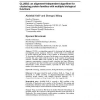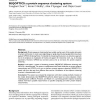1074 search results - page 138 / 215 » Alignment of Non-Overlapping Sequences |
ISMB
1997
13 years 11 months ago
1997
We present a new method for determining the consensus sequence in DNA fragment assemblies. The new method, Trace-Evidence, directly incorporates aligned ABI trace information into...
IJCBDD
2008
13 years 10 months ago
2008
: CLUSS is an algorithm proposed for clustering both alignable and non-alignable protein sequences. However, CLUSS tends to be ineffective on protein datasets that include a large ...
BMCBI
2004
13 years 10 months ago
2004
Background: Hidden Markov Models (HMMs) have proven very useful in computational biology for such applications as sequence pattern matching, gene-finding, and structure prediction...
ISMB
1993
13 years 11 months ago
1993
Using a flexible representation of biological sequences, we have performed a comparative analysis of 1208 known tRNA sequences. We believe we our technique is a more sensitive met...
BMCBI
2006
13 years 10 months ago
2006
Background: Protein sequence clustering has been widely used as a part of the analysis of protein structure and function. In most cases single linkage or graph-based clustering al...


